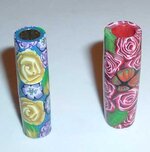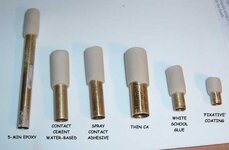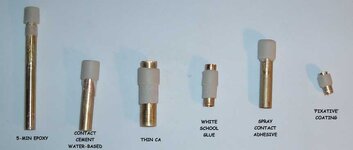Dale Allen
Member
I recently had a brass tube move within the cured PC blank and nearly ruined everything.
This has happened before but I did not want to use the PC anyway.
In this case I was able to remove the brass tube without damage to the PC.
In the first image, the most recent one on the left is after the brass tube was glued back in with 5-min epoxy and the previous one on the right that I never did throw away.
This situation is very much like the blank that EdStreet was working on in his post that reviewed the disassembly of a PC pen.
After the tube was glued back in it turned without issues.
But, I wanted to find a solution to this problem. Somewhere I read that a glue made by Crafter's Pick, called The Ultimate glue, could be used as a bond before the clay was applied. Polymer clay will not bond to the brass tube when it is heat cured. I have also tried a liquid PC before the base layer but that is no different in that the liquid will cure the same as the base layer. What the Ultimate Glue supposedly does is gets re-activated during the heating and glues the PC to the metal.
Unfortunately I cannot find this glue anywhere close to me and being that it is probably not freeze-thaw stable, I do not want to have it shipped to me.
So, I tested the ones I already have in the shop.
The most promising is the 5-minute epoxy, same stuff I used to glue the tube back in.
The first picture of test items below are as noted. These were all prepped by using 400 grit sandpaper on the brass tubes and the glues were applied to the tubes. They were all allowed to dry overnight. Then enough clay was applied to about half of the glued area.
These were all baked at about 280 degrees for 30 minutes. None of the exposed glue areas showed signs of being damaged or in any way effected by the heat.
All subjects were then trimmed and put between centers and a portion of the clay was turned off with a ½" wide scraper tool. Yea, I know, that is not the best tool for the job but it is the most aggressive and that is what I wanted for this test. I have first hand experience that a scraper can turn a PC blank to pieces in short order.
Anyway, the last picture shows that the clay either came loose from the tube or shattered away in pieces on all but the one where the epoxy was used.
Eventually I will do this same test on a tube with the Ultimate glue but for now, I will use some epoxy and maybe this problem won't continue to be an issue.
This has happened before but I did not want to use the PC anyway.
In this case I was able to remove the brass tube without damage to the PC.
In the first image, the most recent one on the left is after the brass tube was glued back in with 5-min epoxy and the previous one on the right that I never did throw away.
This situation is very much like the blank that EdStreet was working on in his post that reviewed the disassembly of a PC pen.
After the tube was glued back in it turned without issues.
But, I wanted to find a solution to this problem. Somewhere I read that a glue made by Crafter's Pick, called The Ultimate glue, could be used as a bond before the clay was applied. Polymer clay will not bond to the brass tube when it is heat cured. I have also tried a liquid PC before the base layer but that is no different in that the liquid will cure the same as the base layer. What the Ultimate Glue supposedly does is gets re-activated during the heating and glues the PC to the metal.
Unfortunately I cannot find this glue anywhere close to me and being that it is probably not freeze-thaw stable, I do not want to have it shipped to me.
So, I tested the ones I already have in the shop.
The most promising is the 5-minute epoxy, same stuff I used to glue the tube back in.
The first picture of test items below are as noted. These were all prepped by using 400 grit sandpaper on the brass tubes and the glues were applied to the tubes. They were all allowed to dry overnight. Then enough clay was applied to about half of the glued area.
These were all baked at about 280 degrees for 30 minutes. None of the exposed glue areas showed signs of being damaged or in any way effected by the heat.
All subjects were then trimmed and put between centers and a portion of the clay was turned off with a ½" wide scraper tool. Yea, I know, that is not the best tool for the job but it is the most aggressive and that is what I wanted for this test. I have first hand experience that a scraper can turn a PC blank to pieces in short order.
Anyway, the last picture shows that the clay either came loose from the tube or shattered away in pieces on all but the one where the epoxy was used.
Eventually I will do this same test on a tube with the Ultimate glue but for now, I will use some epoxy and maybe this problem won't continue to be an issue.



